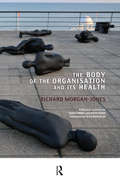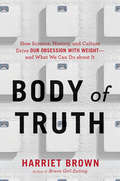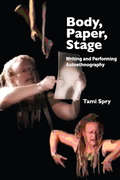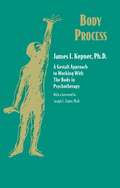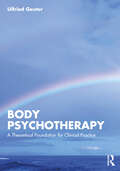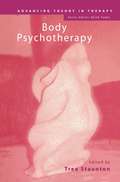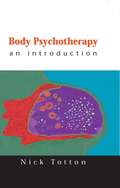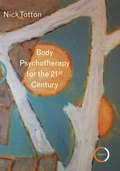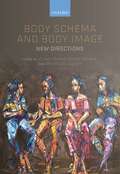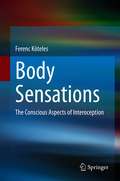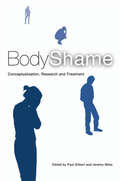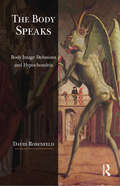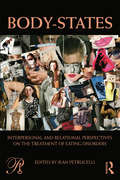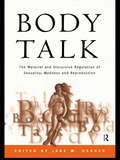- Table View
- List View
The Body of the Organisation and its Health
by Richard Morgan-JonesUsing the frameworks of psychoanalysis, group relations, systemic organisational observation, consulting and research, this book explores the relationship between the health of the work force and the health of organisations. It seeks to do this through an exploration of experience that has three dimensions linked in a single matrix: The bodily, the emotional and the social. This exploration is inspired by Bion's original idea of the protomental matrix from which the group dynamics of basic assumption mentality are derived, leading to his initial ideas about group diseases and their cures.
The Body of the Organisation and its Health
by Richard Morgan-JonesUsing the frameworks of psychoanalysis, group relations, systemic organisational observation, consulting and research, this book explores the relationship between the health of the work force and the health of organisations. It seeks to do this through an exploration of experience that has three dimensions linked in a single matrix: The bodily, the emotional and the social. This exploration is inspired by Bion's original idea of the protomental matrix from which the group dynamics of basic assumption mentality are derived, leading to his initial ideas about group diseases and their cures.
Body of Truth: How Science, History, and Culture Drive Our Obsession with Weight--and What We Can Do about It
by Harriet BrownOver the past twenty-five years, our quest for thinness has morphed into a relentless obsession with weight and body image. In our culture, "fat" has become a four-letter word. Or, as Lance Armstrong said to the wife of a former teammate, "I called you crazy. I called you a bitch. But I never called you fat." How did we get to this place where the worst insult you can hurl at someone is "fat"? Where women and girls (and increasingly men and boys) will diet, purge, overeat, undereat, and berate themselves and others, all in the name of being thin?As a science journalist, Harriet Brown has explored this collective longing and fixation from an objective perspective; as a mother, wife, and woman with "weight issues," she has struggled to understand it on a personal level. Now, in Body of Truth, Brown systematically unpacks what's been offered as "truth" about weight and health.Starting with the four biggest lies, Brown shows how research has been manipulated; how the medical profession is complicit in keeping us in the dark; how big pharma and big, empty promises equal big, big dollars; how much of what we know (or think we know) about health and weight is wrong. And how all of those affect all of us every day, whether we know it or not.The quest for health and wellness has never been more urgent, yet most of us continue to buy into fad diets and unattainable body ideals, unaware of the damage we're doing to ourselves. Through interviews, research, and her own experience, Brown not only gives us the real story on weight, health, and beauty, but also offers concrete suggestions for how each of us can sort through the lies and misconceptions and make peace with and for ourselves.
Body, Paper, Stage: Writing and Performing Autoethnography (Qualitative Inquiry and Social Justice)
by Tami SpryTami Spry provides a methodological introduction to the budding field of performative autoethnography. She intertwines three necessary elements comprising the process. First one must understand the body – navigating concepts of self, culture, language, class, race, gender, and physicality. The second task is to put that body on the page, assigning words for that body’s sociocultural experiences. Finally, this merger of body and paper is lifted up to the stage, crafting a persona as a method of personal inquiry. These three stages are simultaneous and interdependent, and only in cultivating all three does performance autoethnography begin to take shape. Replete with examples and exercises, this is an important introductory work for autoethnographers and performance artists alike.
Body, Paper, Stage: Writing and Performing Autoethnography (Qualitative Inquiry and Social Justice #2)
by Tami SpryTami Spry provides a methodological introduction to the budding field of performative autoethnography. She intertwines three necessary elements comprising the process. First one must understand the body – navigating concepts of self, culture, language, class, race, gender, and physicality. The second task is to put that body on the page, assigning words for that body’s sociocultural experiences. Finally, this merger of body and paper is lifted up to the stage, crafting a persona as a method of personal inquiry. These three stages are simultaneous and interdependent, and only in cultivating all three does performance autoethnography begin to take shape. Replete with examples and exercises, this is an important introductory work for autoethnographers and performance artists alike.
Body Process: A Gestalt Approach to Working with the Body in Psychotherapy
by James I. KepnerTraditional psychotherapy approaches, focusing on working with and correcting mental events and conditions, have placed little importance on the fundamentally physical nature of the person. Yet many of the problems people bring to therapy are linked with or manifested in the body--such as obesity, psychosomatic distress, chronic tension, and sexual problems. This book provides a therapeutic approach that addresses both the physical and mental nature of clients. In this book, James Kepner shows that a client's posture, movements, and bodily experiences are indeed relevant to therapy, and he offers an insightful framework for incorporating these aspects into a therapeutic framework. This comprehensive treatment explains how body work can be integrated with the aims, methods, and philosophy of psychotherapy, offering a framework within which practitioners of different theoretical approaches can better appreciate body processes in the context of the whole person, rather than as isolated events. This book, including an updated introduction by the author, explores the range of body work in psychotherapy, from the development of body awareness to intensive work with physical structure and expression. And it demonstrates how this approach can be particularly effective with a range of clients, including survivors of sexual abuse, recovering drug addicts or alcoholics, or those suffering from chronic illness.
Body Process: A Gestalt Approach to Working with the Body in Psychotherapy
by James I. KepnerTraditional psychotherapy approaches, focusing on working with and correcting mental events and conditions, have placed little importance on the fundamentally physical nature of the person. Yet many of the problems people bring to therapy are linked with or manifested in the body--such as obesity, psychosomatic distress, chronic tension, and sexual problems. This book provides a therapeutic approach that addresses both the physical and mental nature of clients. In this book, James Kepner shows that a client's posture, movements, and bodily experiences are indeed relevant to therapy, and he offers an insightful framework for incorporating these aspects into a therapeutic framework. This comprehensive treatment explains how body work can be integrated with the aims, methods, and philosophy of psychotherapy, offering a framework within which practitioners of different theoretical approaches can better appreciate body processes in the context of the whole person, rather than as isolated events. This book, including an updated introduction by the author, explores the range of body work in psychotherapy, from the development of body awareness to intensive work with physical structure and expression. And it demonstrates how this approach can be particularly effective with a range of clients, including survivors of sexual abuse, recovering drug addicts or alcoholics, or those suffering from chronic illness.
Body Psychotherapy: A Theoretical Foundation for Clinical Practice
by Ulfried GeuterThis book introduces body psychotherapy as one of the essential approaches in psychotherapy, reflecting the increasing integration of the body into clinical mental health practice. The book offers an entirely new view on body psychotherapy based upon advanced research on embodiment, memory, emotion regulation, developmental psychology and body communication and an experiential and relational understanding of psychotherapy. Accordingly, the author grounds the theory of body psychotherapy on the theoretical approach of enactivism, which regards experience as arising from meaningful living interaction with others and their environment. The book, fortified with clinical examples, shows the distinctiveness of body psychotherapy as compared with a traditional talking therapy approach. It also convincingly demonstrates that each form of psychotherapy should consider body experiences. This text will be a comprehensive foundation for psychotherapists of every orientation, scholars of the humanities and students and especially those wishing to integrate embodied experience into their understanding of their patients.
Body Psychotherapy: A Theoretical Foundation for Clinical Practice
by Ulfried GeuterThis book introduces body psychotherapy as one of the essential approaches in psychotherapy, reflecting the increasing integration of the body into clinical mental health practice. The book offers an entirely new view on body psychotherapy based upon advanced research on embodiment, memory, emotion regulation, developmental psychology and body communication and an experiential and relational understanding of psychotherapy. Accordingly, the author grounds the theory of body psychotherapy on the theoretical approach of enactivism, which regards experience as arising from meaningful living interaction with others and their environment. The book, fortified with clinical examples, shows the distinctiveness of body psychotherapy as compared with a traditional talking therapy approach. It also convincingly demonstrates that each form of psychotherapy should consider body experiences. This text will be a comprehensive foundation for psychotherapists of every orientation, scholars of the humanities and students and especially those wishing to integrate embodied experience into their understanding of their patients.
Body Psychotherapy (Advancing Theory in Therapy)
by Tree StauntonIn the past the practice of body psychotherapy has been taken less seriously in professional circles than more traditional psychotherapeutic approaches.Body Psychotherapy redresses the balance, offering insights into a spectrum of approaches within body-oriented psychotherapy. A range of experienced contributors introduce new areas of development and emerging theory and clinical material, covering:* the history of body psychotherapy* theoretical perspectives on body psychotherapy, including post-Reichian and development of integrative methodologies* body psychotherapy in practice, including applications for trauma and regression* the future for body psychotherapy.This book shows how body psychotherapy can be healing, reparative and rewarding. It will make essential reading for postgraduates and professionals, whether they are already involved in this field, or wish to learn more about incorporating it into their own practice.
Body Psychotherapy (Advancing Theory in Therapy)
by Tree StauntonIn the past the practice of body psychotherapy has been taken less seriously in professional circles than more traditional psychotherapeutic approaches.Body Psychotherapy redresses the balance, offering insights into a spectrum of approaches within body-oriented psychotherapy. A range of experienced contributors introduce new areas of development and emerging theory and clinical material, covering:* the history of body psychotherapy* theoretical perspectives on body psychotherapy, including post-Reichian and development of integrative methodologies* body psychotherapy in practice, including applications for trauma and regression* the future for body psychotherapy.This book shows how body psychotherapy can be healing, reparative and rewarding. It will make essential reading for postgraduates and professionals, whether they are already involved in this field, or wish to learn more about incorporating it into their own practice.
Body Psychotherapy (UK Higher Education OUP Humanities & Social Sciences Counselling and Psychotherapy)
by Nick Totton"...a well-rooted resource for bodywork courses and a useful introductory text for a broad audience." Caduceus"It's not a big book but it's got a vast amount of information and knowledge in it. ...if you are interested in getting a good overall picture of the subject you couldn't do better." The FulcrumBody psychotherapy is an holistic therapy which approaches human beings as united bodymind, and offers embodied relationship as its central therapeutic stance. Well-known forms include Reichian Therapy, Bioenergetics, Dance Movement Therapy, Primal Integration and Process Oriented Psychology.This new title examines the growing field of body psychotherapy: Surveys the many forms of body psychotherapy Describes what may happen in body psychotherapy and offers a theoretical account of how this is valuable drawing in current neuroscientific evidence Defines the central concepts of the field, and the unique skills needed by practitioners Accessible and practical, yet grounded throughout in current researchBody Psychotherapy: An Introduction is of interest to practitioners and students of all forms of psychotherapy and counselling, and anyone who wants to understand how mind and body together form a human being.
Body Psychotherapy for the 21st Century
by Nick TottonBody psychotherapy currently attracts more interest than ever before and is taking up an important role in the general psychotherapy field, bringing awareness of embodiment into what has been a verbally oriented profession. It is also developing a sophisticated approach which engages with recent advances in other fields including neuroscience, phenomenology, and cognitive studies, as well as the relational turn in psychotherapy. Body Psychotherapy for the 21st Century charts the history of this transformation and shows how four distinct versions of embodied practice have interacted to generate the current field. It makes the case for body psychotherapy not only within the therapeutic world, but in the social sphere, where bodily difference – of gender, ethnicity, age, sexuality – is one of the major markers of oppression.‘Nick Totton has been a pivotal figure in Body Psychotherapy, both as a historian and as a continual innovator and critic of BP and the whole psychotherapy field. This book has the vitality of genuine re-appraisal and both frankness and rigour in its argument and questions. Definitely a thought-provoking and up to date read.’ Roz Carroll, Relational body psychotherapist, trainer and author‘An exquisite introduction to Body Psychotherapy, describing the influences on its development and the models of working so that people new to this approach will be able to get an image of it. It also offers an excellent and clear overview that can be used by professionals in their further development of theory and methods.’ Lidy Evertsen, Chair, Think Tank of the European Association for Body Psychotherapy
Body Schema and Body Image: New Directions
by Yochai Ataria, Shogo Tanaka and Shaun GallagherBody schema is a system of sensory-motor capacities that function without awareness or the necessity of perceptual monitoring. Body image consists of a system of perceptions, attitudes, and beliefs pertaining to one's own body. In 2005 Shaun Gallagher published an influential book entitled How the Body Shapes the Mind (OUP). That book not only defined both body schema and body image, but explored the complicated relationship between the two. It also established the idea that there is a double dissociation, whereby body schema and body image refer to two different but closely related systems. Given that many kinds of pathological cases can be described in terms of body schema and body image (phantom limbs, asomatognosia, apraxia, schizophrenia, anorexia, depersonalization, and body dysmorphic disorder, among others), we might expect to find a growing consensus about these concepts and the relevant neural activities connected to these systems. Instead, an examination of the scientific literature reveals continued ambiguity and disagreement. This volume brings together leading experts from the fields of philosophy, neuroscience, psychology, and psychiatry in a lively and productive dialogue. It explores fundamental questions about the relationship between body schema and body image, and addresses ongoing debates about the role of the brain and the role of social and cultural factors in our understanding of embodiment.
Body Schema and Body Image: New Directions
Body schema is a system of sensory-motor capacities that function without awareness or the necessity of perceptual monitoring. Body image consists of a system of perceptions, attitudes, and beliefs pertaining to one's own body. In 2005 Shaun Gallagher published an influential book entitled How the Body Shapes the Mind (OUP). That book not only defined both body schema and body image, but explored the complicated relationship between the two. It also established the idea that there is a double dissociation, whereby body schema and body image refer to two different but closely related systems. Given that many kinds of pathological cases can be described in terms of body schema and body image (phantom limbs, asomatognosia, apraxia, schizophrenia, anorexia, depersonalization, and body dysmorphic disorder, among others), we might expect to find a growing consensus about these concepts and the relevant neural activities connected to these systems. Instead, an examination of the scientific literature reveals continued ambiguity and disagreement. This volume brings together leading experts from the fields of philosophy, neuroscience, psychology, and psychiatry in a lively and productive dialogue. It explores fundamental questions about the relationship between body schema and body image, and addresses ongoing debates about the role of the brain and the role of social and cultural factors in our understanding of embodiment.
Body Sensations: The Conscious Aspects of Interoception
by Ferenc KötelesThe monograph aims to present the recent scientific knowledge on body sensations, i.e., conscious experiences that are localized or felt in the body from an internal perspective, regardless of their sensory origin. It summarizes the basic philosophical, evolutionary, neuroanatomical, psychological, and pathological aspects of the topic. Moreover, related phenomena, such as emotions, the placebo and nocebo effect, complementary and alternative medicine, and mind-body practices are discussed from the perspective of body sensations.
Body Shame: Conceptualisation, Research and Treatment
by Paul Gilbert Jeremy MilesPhysical appearance plays a powerful role in social relationships. Those who feel shame regarding the way they look, and who think others view their appearance negatively, can therefore be vulnerable to impoverished social relationships and a range of psychological difficulties. However, there are a few books which look specifically at the many permutations of body shame and their differing treatments.In this book, researchers and therapists from a wide range of different disciplines and areas explore the role of shame in various physical and psychological disorders, and provide practical advice on management and treatment. Chapters are organised to address issues of conceptualisation, assessment and treatment, on topics such as:* definitional controversies* possible biopsychosocial and evolutionary origins of body shame* effects on adjustment to maturation and aging process* specific forms of disfigurement* the role of body shame in depression, eating disorders and body dysmorphic disorder.Body Shame gives the reader insight into the nature and mechanisms of shame, how it can focus on the body, how it can underlie a variety of psychological difficulties, and how to intervene to help resolve it. This book will be invaluable for practitioners from different disciplines working with people who have problems centred on their physical appearance and/or functions, and clinicians working with various mental health problems.
Body Shame: Conceptualisation, Research and Treatment
by Paul Gilbert Jeremy MilesPhysical appearance plays a powerful role in social relationships. Those who feel shame regarding the way they look, and who think others view their appearance negatively, can therefore be vulnerable to impoverished social relationships and a range of psychological difficulties. However, there are a few books which look specifically at the many permutations of body shame and their differing treatments.In this book, researchers and therapists from a wide range of different disciplines and areas explore the role of shame in various physical and psychological disorders, and provide practical advice on management and treatment. Chapters are organised to address issues of conceptualisation, assessment and treatment, on topics such as:* definitional controversies* possible biopsychosocial and evolutionary origins of body shame* effects on adjustment to maturation and aging process* specific forms of disfigurement* the role of body shame in depression, eating disorders and body dysmorphic disorder.Body Shame gives the reader insight into the nature and mechanisms of shame, how it can focus on the body, how it can underlie a variety of psychological difficulties, and how to intervene to help resolve it. This book will be invaluable for practitioners from different disciplines working with people who have problems centred on their physical appearance and/or functions, and clinicians working with various mental health problems.
The Body Speaks: Body Image Delusions and Hypochondria
by David RosenfeldThis book explores the author's pioneering work with severely disturbed patients, to show what it means to work and think as a psychoanalyst about transference and the internal world of a psychotic patient, with all the difficulties involved in continuing to treat and engage with even severely ill patients. As the author suggests, to be a psychoanalyst is to think about transference, the patient's internal world and projective identifications onto the therapist and onto persons in the external world. In particular, the author examines patients who express their mental state through fantasies about their body image. For example, the fantasy of an emptying of the self is discussed through the case of the patient Pierre, who asserts that he has no more blood or liquids in his body. Similarly, the fantasies of a young man who says that bats are flying out of his cheeks incarnate the anxiety of his first months of life expressed through his body. Indeed, the author's particular focus is on the importance of the first months and years in the life of these patients.
The Body Speaks: Body Image Delusions and Hypochondria
by David RosenfeldThis book explores the author's pioneering work with severely disturbed patients, to show what it means to work and think as a psychoanalyst about transference and the internal world of a psychotic patient, with all the difficulties involved in continuing to treat and engage with even severely ill patients. As the author suggests, to be a psychoanalyst is to think about transference, the patient's internal world and projective identifications onto the therapist and onto persons in the external world. In particular, the author examines patients who express their mental state through fantasies about their body image. For example, the fantasy of an emptying of the self is discussed through the case of the patient Pierre, who asserts that he has no more blood or liquids in his body. Similarly, the fantasies of a young man who says that bats are flying out of his cheeks incarnate the anxiety of his first months of life expressed through his body. Indeed, the author's particular focus is on the importance of the first months and years in the life of these patients.
Body-States: Interpersonal And Relational Perspectives On The Treatment Of Eating Disorders (Psychoanalysis in a New Key Book Series)
by Jean PetrucelliIn this edited volume, Jean Petrucelli brings together the work of talented clinicians and researchers steeped in working with eating disordered patients for the past 10 to 35 years. Eating disorders are about body-states and their relational meanings. The split of mindbody functioning is enacted in many arenas in the eating disordered patient’s life. Concretely, a patient believes that disciplining or controlling his or her body is a means to psychic equilibrium and interpersonal effectiveness. The collected papers in Body-States: Interpersonal and Relational Perspectives on the Treatment of Eating Disorders elaborates the essential role of linking symptoms with their emotional and interpersonal meanings in the context of the therapy relationship so that eating disordered patients can find their way out and survive the unbearable. The contributors bridge the gaps in varied protocols for recovery, illustrating that, at its core, trust in the reliability of the humanness of the other is necessary for patients to develop, regain, or have - for the first time - a stable body. They illustrate how embodied experience must be cultivated in the patient/therapist relationship as a felt experience so patients can experience their bodies as their own, to be lived in and enjoyed, rather than as an ‘other’ to be managed. In this collection Petrucelli convincingly demonstrates how interpersonal and relational treatments address eating problems, body image and "problems in living." Body States: Interpersonal and Relational Perspectives on the Treatment of Eating Disorders will be essential reading for psychoanalysts, psychotherapists, psychologists, psychiatrists, social workers, and a wide range of professionals and lay readers who are interested in the topic and treatment of eating disorders.
Body-States: Interpersonal And Relational Perspectives On The Treatment Of Eating Disorders (Psychoanalysis in a New Key Book Series)
by Jean PetrucelliIn this edited volume, Jean Petrucelli brings together the work of talented clinicians and researchers steeped in working with eating disordered patients for the past 10 to 35 years. Eating disorders are about body-states and their relational meanings. The split of mindbody functioning is enacted in many arenas in the eating disordered patient’s life. Concretely, a patient believes that disciplining or controlling his or her body is a means to psychic equilibrium and interpersonal effectiveness. The collected papers in Body-States: Interpersonal and Relational Perspectives on the Treatment of Eating Disorders elaborates the essential role of linking symptoms with their emotional and interpersonal meanings in the context of the therapy relationship so that eating disordered patients can find their way out and survive the unbearable. The contributors bridge the gaps in varied protocols for recovery, illustrating that, at its core, trust in the reliability of the humanness of the other is necessary for patients to develop, regain, or have - for the first time - a stable body. They illustrate how embodied experience must be cultivated in the patient/therapist relationship as a felt experience so patients can experience their bodies as their own, to be lived in and enjoyed, rather than as an ‘other’ to be managed. In this collection Petrucelli convincingly demonstrates how interpersonal and relational treatments address eating problems, body image and "problems in living." Body States: Interpersonal and Relational Perspectives on the Treatment of Eating Disorders will be essential reading for psychoanalysts, psychotherapists, psychologists, psychiatrists, social workers, and a wide range of professionals and lay readers who are interested in the topic and treatment of eating disorders.
Body Talk: The Material and Discursive Regulation of Sexuality, Madness and Reproduction
by Jane UssherPsychology has traditionally examined human experience from a realist perspective, focusing on observable 'facts'. This is especially so in areas of psychology which focus on the body, such as sexuality, madness or reproduction. In contrast, many sociologists, anthropologists and feminists have focused exclusively on the cultural and communicative aspects of 'the body' treating it purely as an object constructed within socio-cultural discourse.This new collection of sophisticated discursive analyses explores this divide from a variety of theoretical standpoints, including psychoanalysis, social representations theory, feminist theory, critical realism, post-structuralism and social constructionism.Body Talk reconciles the divide by putting forward a new 'materialist-discursive' approach. It also provides an introduction to social constructionist and discursive approaches which is accessible to those with limited previous knowledge of socio-linguistic theory, and showcases the distinctive contribution that psychologists can make to the field.
Body Talk: The Material and Discursive Regulation of Sexuality, Madness and Reproduction
by Jane UssherPsychology has traditionally examined human experience from a realist perspective, focusing on observable 'facts'. This is especially so in areas of psychology which focus on the body, such as sexuality, madness or reproduction. In contrast, many sociologists, anthropologists and feminists have focused exclusively on the cultural and communicative aspects of 'the body' treating it purely as an object constructed within socio-cultural discourse.This new collection of sophisticated discursive analyses explores this divide from a variety of theoretical standpoints, including psychoanalysis, social representations theory, feminist theory, critical realism, post-structuralism and social constructionism.Body Talk reconciles the divide by putting forward a new 'materialist-discursive' approach. It also provides an introduction to social constructionist and discursive approaches which is accessible to those with limited previous knowledge of socio-linguistic theory, and showcases the distinctive contribution that psychologists can make to the field.
Body Technologies in the Greco-Roman World: Technosôma, gender and sex
by Maria Gerolemou and Giulia Maria ChesiA collection of papers that introduces the notion of the technosoma (techno body) into discussions on the representations of the body in classical antiquity. By applying the category of the technosoma to the ‘natural’ body, this volume explicitly narrows down the discussion of the technical and the natural to the physiological body. In doing so, the present collection focuses on body technologies in the specific form of beautification and body enhancement techniques, as well as medical and surgical treatments. The volume elucidates two main points. Firstly, ancient techno bodies show that the categories of gender and sexuality are at the core of the intersection of the natural and the technical, and intersect with notions of race, age, speciesism, class and education, and dis/ability. Secondly, the collection argues that new body technologies have in fact a very ancient history that can help to address the challenges of contemporary technological innovation. To this end, the volume showcases the intersection of ‘natural’ bodies with technology, gender, sexuality and reproduction. On the one hand, techno bodies tend to align with normative ideas about gender, and sexuality. On the other hand, body modification and/or enhancement techniques work hand in hand with economic and political power and knowledge, thus they often produce techno bodies that are shaped according to individual needs, i.e. according to a certain lifestyle. Consequently, techno bodies threaten to alter traditional ideas of masculinity, femininity, male and female sexuality and beauty.
